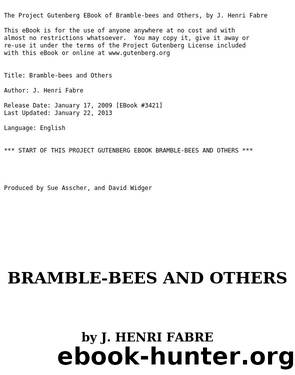Bramble-Bees and Others by Jean-Henri Fabre

Author:Jean-Henri Fabre [Fabre, Jean-Henri]
Language: eng
Format: epub
Tags: Bees
Published: 2002-08-31T16:00:00+00:00
CHAPTER 9. THE COTTON-BEES.
The evidence of the Leaf-cutters proves that a certain latitude is left to the insect in its choice of materials for the nest; and this is confirmed by the testimony of the Anthidia, the cotton-manufacturers. My district possesses five: A. Florentinum, LATR., A. diadema, LATR., A. manicatum, LATR., A. cingulatum, LATR., A. scapulare, LATR. None of them creates the refuge in which the cotton goods are manufactured. Like the Osmiae and the Leaf-cutters, they are homeless vagrants, adopting, each to her own taste, such shelter as the work of others affords. The Scapular Anthidium is loyal to the dry bramble, deprived of its pith and turned into a hollow tube by the industry of various mining Bees, among which figure, in the front rank, the Ceratinae, dwarf rivals of the Xylocopa, or Carpenter-bee, that mighty driller of rotten wood. The spacious galleries of the Masked Anthophora suit the Florentine Anthidium, the foremost member of the genus so far as size is concerned. The Diadem Anthidium considers that she has done very well if she inherits the vestibule of the Hairy-footed Anthophora, or even the ordinary burrow of the Earth-worm. Failing anything better, she may establish herself in the dilapidated dome of the Mason-bee of the Pebbles. The Manicate Anthidium shares her tastes. I have surprised the Girdled Anthidium cohabiting with a Bembex-wasp. The two occupants of the cave dug in the sand, the owner and the stranger, were living in peace, both intent upon their business. Her usual habitation is some hole or other in the crevices of a ruined wall. To these refuges, the work of others, we can add the stumps of reeds, which are as popular with the various cotton-gatherers as with the Osmiae; and, after we have mentioned a few most unexpected retreats, such as the sheath provided by a hollow brick or the labyrinth furnished by the lock of a gate, we shall have almost exhausted the list of domiciles.
Like the Osmiae and the Leaf-cutters, the Anthidium shows an urgent need of a ready-made home. She never houses herself at her own expense. Can we discover the reason? Let us first consult a few hard workers who are artificers of their own dwellings. The Anthophora digs corridors and cells in the road-side banks hardened by the sun; she does not erect, she excavates; she does not build, she clears. Toiling away with her mandibles, atom by atom, she manages to contrive the passages and chambers necessary for her eggs; and a huge business it is. She has, in addition, to polish and glaze the rough sides of her tunnels. What would happen if, after obtaining a home by dint of long-continued toil, she had next to line it with wadding, to gather the fibrous down from cottony plants and to felt it into bags suitable for the honey-paste? The hard-working Bee would not be equal to producing all these refinements. Her mining calls for too great an expenditure of time and strength to leave her the leisure for luxurious furnishing.
Download
This site does not store any files on its server. We only index and link to content provided by other sites. Please contact the content providers to delete copyright contents if any and email us, we'll remove relevant links or contents immediately.
Kathy Andrews Collection by Kathy Andrews(10562)
The remains of the day by Kazuo Ishiguro(7582)
Spare by Prince Harry The Duke of Sussex(4228)
Paper Towns by Green John(4179)
The Body: A Guide for Occupants by Bill Bryson(3829)
Be in a Treehouse by Pete Nelson(3238)
Harry Potter and the Goblet Of Fire by J.K. Rowling(3098)
Goodbye Paradise(2985)
Never by Ken Follett(2915)
Into Thin Air by Jon Krakauer(2714)
The Remains of the Day by Kazuo Ishiguro(2629)
The Genius of Japanese Carpentry by Azby Brown(2619)
The Cellar by Natasha Preston(2607)
Drawing Shortcuts: Developing Quick Drawing Skills Using Today's Technology by Leggitt Jim(2537)
120 Days of Sodom by Marquis de Sade(2449)
Architecture 101 by Nicole Bridge(2358)
Machine Learning at Scale with H2O by Gregory Keys | David Whiting(2325)
The Man Who Died Twice by Richard Osman(2313)
Industrial Automation from Scratch: A hands-on guide to using sensors, actuators, PLCs, HMIs, and SCADA to automate industrial processes by Olushola Akande(2163)
